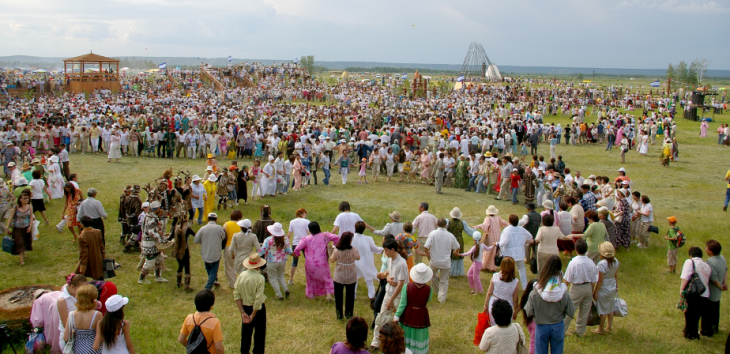In their effort to create an atheist, materialist communist society, successive Soviet administrations sought to eliminate traditions and practices that stemmed from other worldviews. Religious practitioners or adherents – be they Christian, Muslim, Buddhist, or shamanist – were thought and spoken of as a threat to the Soviet state and its future. Hundreds of thousands of priests, imams, lamas and shamans were imprisoned or killed during the Stalinist repressions, while religious practices and institutions vanished from public view all over the Soviet Union. And yet religion never disappeared entirely: the promoters of Soviet atheism found that severing ties with established spiritual entities and traditions was a convoluted and challenging task. A small fraction of Russia’s religious places and congregations continued to exist. A handful of shamans were living and practising in Sakha (Yakutia) throughout the Soviet period – while Sakha communities would perform small shamanic rituals unobtrusively, especially in remote areas.
Yakutia’s earlier Soviet administrations did not attempt to forbid the Ysyakh. Instead, they incorporated the festival into their drive to win the hearts and minds of Sakha people round to the Soviet state and its modernising project. Secular Ysyakh rituals were organised and promoted, during which kumys was presented to portraits of Stalin. Large Ysyakhs were held all over Yakutia in 1945, both to celebrate the end of the Second World War, and to mollify a Sakha population exhausted by the war effort. These Ysyakh holidays could include the sports, dancing, eating and drinking of former years – but the communication with the deities was replaced by formal speeches, on exclusively secular themes. As time went on, any Ysyakh celebrations that took place became increasingly hard to differentiate from the other Soviet state holidays. Communion with the shamanic deities had to occur at other places and times, in secret. Prayer-poems were performed in public as a genre of folk music, devoid of any cosmological significance. Many Sakha people also came to regard the Ysyakh and its spiritual purpose as obsolete, and irrelevant.
A renewed interest in the Sakha shamanic tradition emerged during the 1980s, particularly within the intellectual and artistic establishments. Sakha academics, artists, theatre directors, and performers claimed a new importance for both the Sakha heritage and its shamanic cultural forms, making them the focus of their work. These productions also asserted the Sakha people’s right to a higher level of political autonomy. Large public Ysyakh rituals became the focus of this activity towards the end of the 1980s, and the first administration of the new Republic of Sakha (Yakutia) instituted the Ysyakh as a state holiday in 1992.

